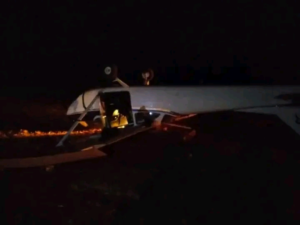Trending
Middle East updates: Israel sends troops to southwest Lebanon
Israel’s army expanded ground operations to Lebanon’s southwest, as Hezbollah says it has repelled the incursion.
Israel has expanded its ground operations to Lebanon’s southwest Hezbollah says its capabilities remain ‘intact’ Major airlines cancel flights to Beirut and Tel Aviv
Here are the latest developments regarding the Israel-Lebanon escalation, Gaza and the wider Middle East region on Tuesday, October 8:
Major airlines cancel flights to Middle East
Major international airlines canceled flights to the region amid concerns over a wider conflict, with Israel’s commercial hub of Tel Aviv and Lebanon’s capital Beirut most affected.
US airline Delta, Germany’s Lufthansa and Italy’s ITA Airways all canceled flights to Tel Aviv until October 31, while low-budget UK carrier EasyJet extended its flight suspensions until March 30, 2025. Air India has suspended its flights to Tel Aviv until further notice.
The French and Dutch group Air France-KLM extended its flight suspensions to Beirut to October 26, while Turkish airline Pegasus canceled flights to Beirut until October 28. UAE’s Emirates airline canceled flights to Beirut through October 15, while others, like Algeria’s Air Algerie and Qatar Airways, suspended flights to Lebanon indefinitely.
Other cities in the vicinity of the conflict have also been affected. Qatar’s national carrier also suspended flights to Iran and Iraq, while Spanish low-cost carrier Vueling canceled flights to Amman, Jordan until further notice.
A major route connecting Iran and Lebanon has also been suspended, with Iran Air canceling all flights to and from Beirut until further notice.
Hezbollah leader says group’s capability is intact
Hezbollah’s deputy leader, Naim Kassem, said in a televised address on Tuesday that the group’s capabilities were intact and its fighters were repelling Israeli ground incursions despite the “painful blows” the militant group suffered in recent weeks.
Kassem warned that more Israelis will be displaced as the militant group expands its rocket fire deeper into Israel.
“We are firing hundreds of rockets and dozens of drones. A large number of settlements and cities are under the fire of the resistance,” Kassem said.
But Hezbollah’s acting leader also said the group supported the efforts by Lebanon’s Speaker of Parliament Nabih Berri to secure a cease-fire. He did not provide any further details on possible conditions Hezbollah demands. The group previously said a cease-fire in Lebanon would be reliant on a cease-fire in Gaza.
Kassem said that Hezbollah is expected to name a new leader to succeed Hassan Nasrallah, who was killed in an Israeli airstrike in Beirut last month, “but the circumstances are difficult because of the war.”
Israel says it began operations in southwest Lebanon
The Israeli military said on Tuesday that ground operations in southwest Lebanon had begun in a move that would expand its incursions to a new zone in its ongoing fight with the militant group Hezbollah.
Iran-backed Hezbollah is considered a terrorist organization by the US, Germany and several Sunni Arab countries, while the EU lists its armed wing as a terrorist group.
“Yesterday (Monday), the 146th Division began limited, localized, targeted operational activities against Hezbollah terror targets and infrastructure in southwestern Lebanon,” the military said in a statement on its Telegram channel.
The announcement comes after Israel’s military struck Beirut’s southern suburbs overnight, saying a senior Hezbollah official responsible for the group’s budgeting and logistics had been killed.
The Israel Defense Forces have also imposed a naval blockade stretching 60 kilometers (37 miles) along Lebanon’s southern Mediterranean coast. The IDF warned civilians that going to beaches or heading out to sea on boats is “life-threatening” until further notice.
Trending
Actress Doris Ogala reacts to Pastor Chris Okafor’s wedding, makes fresh explosive claims

Actress Doris Ogala has reacted strongly to Pastor Chris Okafor’s wedding, insisting that the public does not know what is really going on behind the scenes.
In a new outburst following reports of the wedding, Doris alleged that the marriage was forced, claiming the bride was r*ped and got pregnant and that the situation was allegedly used to prevent public exposure. According to her, the bride’s mother is his church’s choir coordinator and allegedly insisted on marriage to avoid scandal.
Doris further claimed that Pastor Chris had another woman he was allegedly set to marry on the 24th, adding that she has chats and videos she says support her claims. She described the situation as darker than it appears and said her decision to speak out was deliberate, despite the personal cost.
She maintained that her earlier confessions and allegations were part of what she described as a spiritual and personal reckoning, stating that she felt compelled to expose what she believes has been hidden.
https://www.instagram.com/reel/DSXz6ZLDMRY/?igsh=YjJyaHJ4bWNxdHg1
Trending
Kwara Govt Confirms Arrested Armed Men Are Miyetti Allah Members, Not Bandits

The Kwara State Government has provided clarification on the viral video showing armed men, initially believed to be bandits, being interrogated by soldiers, a development that had sparked widespread public anger and calls for a state of emergency.
The state official confirmed that the men apprehended were part of a security operation coordinated by the Federal Government, raising fresh controversy over the use of armed non-state actors in counter-insurgency efforts.
Speaking on Informant247, Ibrahim Abdulateef, Senior Special Assistant on Communication to the Governor, confirmed the arrested individuals were members of Miyetti Allah who were incorporated into a Joint Task Force following the deadly September 29 attacks in Ifelodun LGA.
“Under their security setup, they use both recognized officers and a JTF which includes members of Miyetti Allah and local vigilante networks,” Abdulateef said.
The controversy deepened as the state confirmed that a patrol vehicle was provided through the local government chairman “in a bid to empower security forces.”
The government denied the men were arrested as bandits in Kwara. Instead, Abdulateef alleged that after the men completed their assignment, they “absconded with the patrol van” and were subsequently arrested by soldiers “in Auchi, Edo State, not anywhere in Kwara.”
According to Sahara Reporters, the Chief Press Secretary to the Governor, Rafiu Ajakaye, further clarified the identity of an official named in the suspects’ confession: “Victor is a police sergeant attached to the NSA Office,” and not a DSS or Air Force officer as speculated.
Ajakaye disclosed that Victor and the vigilante operatives had since left Kwara State in line with the position of affected local communities, a decision the government said it respected.
He cautioned against sensational reporting of sensitive security matters, describing the situation as a “secrecy dilemma” that requires balance to ensure accountability without undermining national security efforts.
“We are going through a difficult phase in national security emergency. The pain of losing our brothers and sisters and of losing our peace of mind cannot be quantified. Losing a soul is a tragedy — much less many souls,” he said in a WhatsApp post.
He called for calm, urging political elites and community leaders to act with tact and responsibility amid rising tensions.
“But statesmen and patriots aren’t known in time of peace and ease. The elite (who shoulder the burden of guiding the masses) need to handle these whole things with a lot of tact and patriotism,” he said.
“May God guide us, restore peace in our land, expose the evil doers and their collaborators, and make our country stronger, more peaceful, and more prosperous,” the CPS added. “This is a time for careful leadership, not reckless accusations.”
The state’s confirmation of the use of Miyetti Allah members in armed operations comes after previous reports highlighted strong opposition from Kwara residents and local Fulani leaders to an alleged plan by the National Security Adviser (NSA), Nuhu Ribadu, to deploy and arm Fulani herders (Bororos) with AK-47 rifles to fight banditry.
Local Fulani stakeholders had warned that arming non-state actors could worsen insecurity, citing the failure of similar previous attempts and the volatility of migrant herders.
Both the Kwara State Government and Miyetti Allah initially denied any arrangement involving the arming of herders or collaboration with bandits.
Trending
4 Rushed To Hospital as Aircraft Crash-Lands at Imo Airport

By Dan Opara
A light aircraft, Cessna 172, operated by Skypower Express, crash landed on Tuesday night, December 16, 2025, at the Sam Mbakwe International Cargo Airport, Owerri, Imo State, resulting in the hospitalization of four persons.

Eyewitnesses said the aircraft encountered difficulties during landing, lost stability on the runway, and subsequently somersaulted before coming to a halt within the airport premises.
The incident triggered panic among airport personnel and onlookers, although no lives were lost.
Emergency response teams were swiftly deployed to the scene, where the injured occupants were rescued and immediately transported to a nearby medical facility for urgent treatment.
Airport officials confirmed that the four victims are currently receiving medical care, and their condition was described as stable as of the time of filing this report.
The Nigerian Safety Investigation Bureau, NSIB, has commenced a formal investigation into the incident to ascertain both the immediate and underlying causes of the crash landing.
The investigation is expected to focus on the aircraft’s technical condition, prevailing weather conditions, pilot actions, and other operational factors surrounding the occurrence.

Following the accident, airport operations were temporarily disrupted, but normal activities were later restored after safety officials secured the affected area.
Authorities at the airport assured the public that all necessary safety measures are being strengthened to prevent a recurrence.
Meanwhile, stakeholders within the aviation sector have expressed concern over the incident and called for a comprehensive and transparent investigation to further enhance aviation safety standards in the country.
Ekwutosblog gathered the report through monitored information circulating on social media, as prayers and goodwill messages continue to pour in for the quick recovery of those hospitalized, while the public awaits the outcome of the NSIB investigation.

-
Business1 year ago
US court acquits Air Peace boss, slams Mayfield $4000 fine
-

 Trending1 year ago
Trending1 year agoNYA demands release of ‘abducted’ Imo chairman, preaches good governance
-

 Politics1 year ago
Politics1 year agoMexico’s new president causes concern just weeks before the US elections
-

 Politics1 year ago
Politics1 year agoPutin invites 20 world leaders
-

 Politics1 year ago
Politics1 year agoRussia bans imports of agro-products from Kazakhstan after refusal to join BRICS
-
Entertainment1 year ago
Bobrisky falls ill in police custody, rushed to hospital
-
Entertainment1 year ago
Bobrisky transferred from Immigration to FCID, spends night behind bars
-
Education1 year ago
GOVERNOR FUBARA APPOINTS COUNCIL MEMBERS FOR KEN SARO-WIWA POLYTECHNIC BORI













